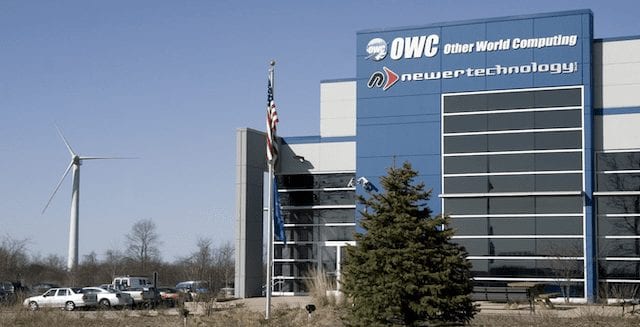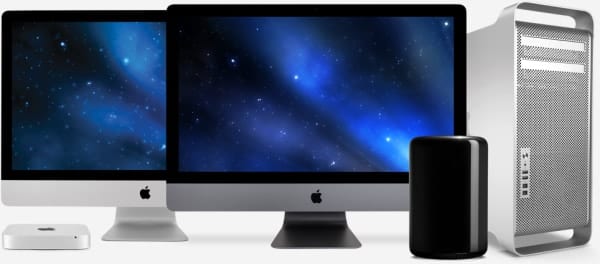Over the past ten years, a revolution has been taking place in personal computing: hard disk drives (HDDs), which store data on spinning platters, have given way to silent, non-mechanical solid state drives (SSDs). Chances are good that if you have an older Mac, it has an internal hard disk drive. Today, we’ll look at five reasons why you should update that Mac to an SSD.
1) SSDs Are Much Faster
Storage speed can make a big difference on how happy you are with your Mac! If all you’re doing is some web browsing and sending or receiving emails, the 160 to 250 MB/s (megabytes per second) transfer speeds to and from a hard disk drive are fine. Start doing data-intensive work like video editing or composing music with multiple virtual instruments, and you’ll find that an HDD just can’t keep up.

With a high-performance SSD like the OWC Aura Pro X, it’s possible to achieve read rates of up to 1352 MB/s and sustained write speeds of 1066 MB/s. With speeds like that, there’s no pausing or stuttering while video is being rendered and your Mac starts up in seconds, not minutes.
2) SSDs Can Survive Drops and Bumps
Although HDDs have been equipped with ways of keeping them from being damaged when dropped, the fact remains that those spinning platters don’t take kindly to being bumped. Any device with moving parts — like an HDD — can break if dropped.
SSDs, however, take bumps and drops in stride. Using solid state flash memory for storage, there are absolutely no moving parts to break. For durability, SSDs are absolutely the best option.
3) SSDs Have A Longer Service Life
Speaking of reliability, SSDs last longer than HDDs. A paper published and presented at the 2016 Usenix conference showed that standard HDDs have a failure rate of 2 to 9 percent each year. By comparison, 4 to 10 percent of SSDs fail every four years. That failure rate means that important information is less likely to be lost in a drive failure on an SSD than on an HDD. Regardless of how low the failure rate is, it’s still important to have at least one backup. (Related article: Do HDDs or SSDs Need ‘Exercise’? The Rocket Yard Investigates)
4) SSDs Use Less Power
Think of the billions of computing devices now on Planet Earth, then think of the electrical power required to spin the platters and move the read/write heads on an HDD. For an SSD, power is used only to keep the internal circuitry up and running — and that’s a comparative trickle compared to the amounts required by an HDD. Sure, switching from an HDD to an SSD might not make a noticeable impact on your electrical bill, but if you’re running a data center it can make a huge difference.

Less power also means that devices run cooler, which can also impact data centers where air conditioning is a necessity to keep devices from literally burning up. A move to SSDs can reduce cooling requirements, lowering electricity bills even more, and making the use of renewable energy sources more likely. You can read more about OWC’s sustainability initiative here.
5) SSDs Are Quieter Than HDDs
The final reason that SSDs are a great choice for storage? They’re completely silent. While your desktop iMac or Mac mini still has a very quiet cooling fan that kicks in when things get hot inside the computer casing, you’re more likely to hear the clicking and whirring of an HDD than notice the fan noise. In fact, since an SSD runs cooler than an HDD, chances are good that the fan won’t kick in as much, making your entire world a lot less noisy.
However, all of this isn’t to say that HDDs have no place in modern workflows. Check out this Rocket Yard article to see how you can best utilize HDDs: Spin Class: Five of the Best Reasons to Use HDDs








re: SSDs Use Less Power
How much less power? Why mention if you don’t want to be bothered with finding out what the actual differences are?
The other day, my dear spouse (really)”lost” an immensely important file(?) that contained all of our financial records. She said she didn’t drag it into the trash, but for the life of me I can’t find it. Can you help me try to recover it? Thanks. BU
Older SSD’s like Samsung EVO 850 series are 2 bit data paths vs. what is called 2 or more bytes 3D which is more robust. Of note is that it is absolutely crucial to maintain a minimum of 10% free space in order to extend the drives life or MTBF (mean time before failure) If a drive is near full it must rearrange large sections of data to organize its files properly rapidly using up the finite number of writes that can be sustained. To be transparent , Some newer premium drives keep a 10% physical cache that can not be user accessed and these are worth the premium price for those engaged in Science, Film , Music and other application types that write large files at once. All in all SSD’s especially in laptops are a must have.
You kind of left out the most important reason for an SSD in High Sierra or later: APFS just plain SUCKS on platter based drives.
It’s a filesystem with decent features, but with one fatal flaw: Every time your file(s) are updated or changed, a new b-tree extents node is created instead of updating the existing one. So if you have a file that gets ten separate revisions, it gets ten additional extents nodes.
Now let’s put another frustrating filesystem on the table: Blizzard Entertainment’s CASC filesystem for its modern games. Due to the way it manages its indexes and data files and how it injects data into the file directly while retaining invalidated data (because of how patch cycles work), those b-tree extents nodes become MUCH more of a problem. We’re talking literally thousands of nodes per data file now.
CASC itself is already dog slow by itself on platter based HDs. Add in APFS and you can get load times of 30 minutes for a zone in World of Warcraft that hasn’t been freshly reinstalled to alleviate the data fragmentation and b-tree extents problems.
APFS vs. HFS+ can still adversely affect SSDs to though. World of Warcraft’s Deadly Boss Mods author found that instead of getting the 2.5 GB/sec throughput he should be seeing on his NVMe drive, he got a pitiful 700 MB/sec. Formatting the drive as HFS+ brought that back up to expected speeds.
So basically the gist here is that you want an SSD as of 10.13 and later just to maintain any semblance of expected performance, but thanks to APFS’ horrible performance even SSDs are bogged down unnecessarily.
SSD advantages are great, but also disadvantages should be indicated. For instance, limited number of writes and data loss if not powered in years. Do not get me wrong, I love SSD and do not want mechanical rotational ones any more. But fair is fair. Do not hide information. Do not be evil, as Google said! Thanks.